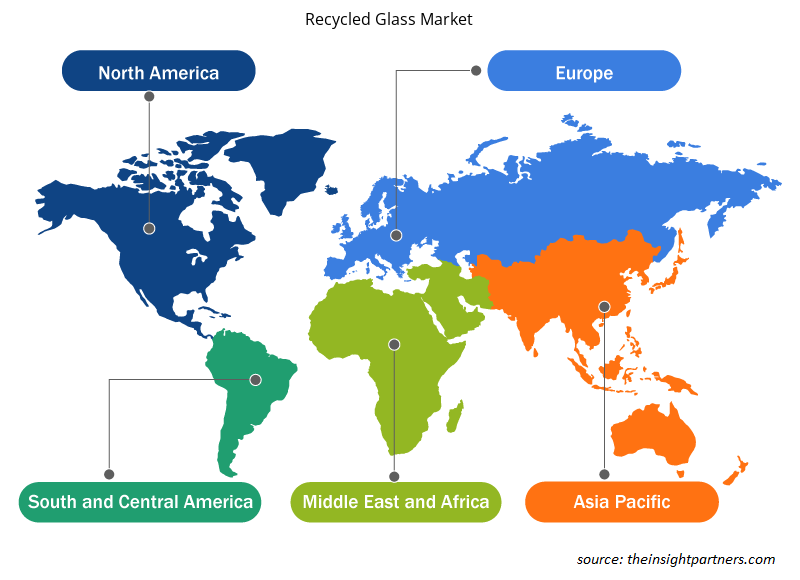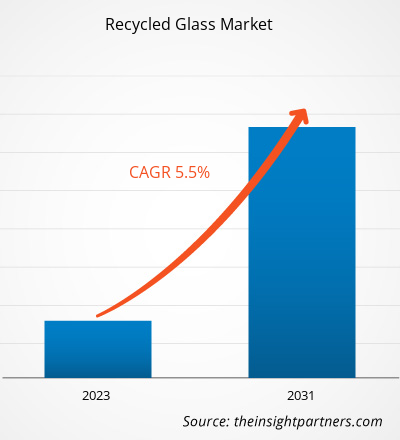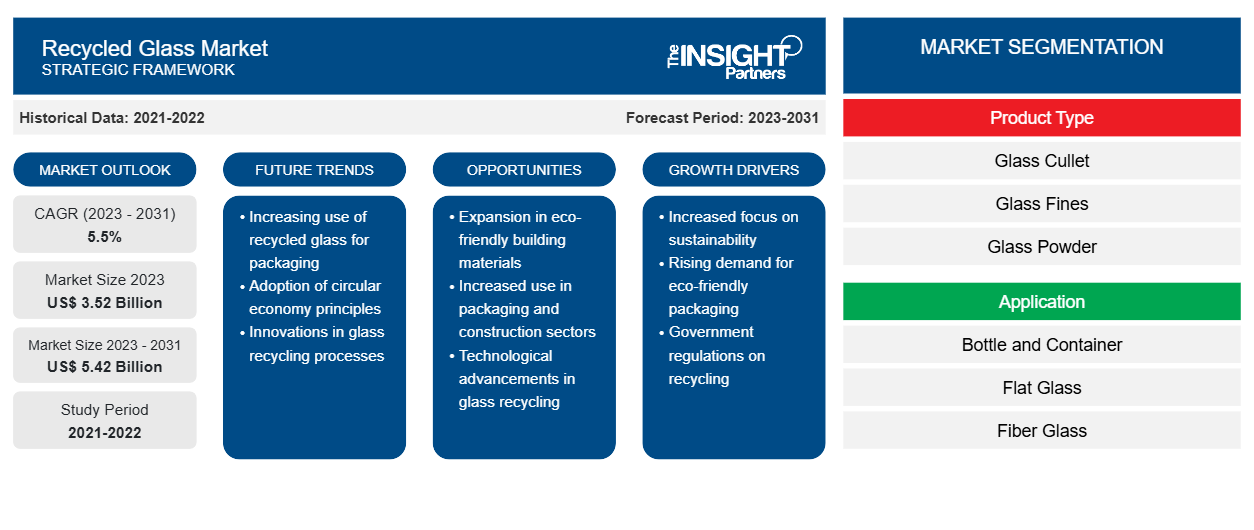Si prevede che la dimensione del mercato del vetro riciclato raggiungerà i 5,42 miliardi di dollari entro il 2031, rispetto ai 3,52 miliardi di dollari del 2023. Si prevede che il mercato registrerà un CAGR del 5,5% nel 2023-2031. È probabile che la crescente attenzione allo sviluppo sostenibile rimanga una tendenza chiave del mercato del vetro riciclato.CAGR of 5.5% in 2023–2031. The growing focus on sustainable development is likely to remain a key Recycled Glass Market trend.
Analisi del mercato del vetro riciclato
Il vetro riciclato è ampiamente utilizzato nell'industria alimentare e delle bevande per il confezionamento di bevande e prodotti alimentari, il che sta aumentando la domanda da parte dell'industria delle bottiglie e dei contenitori. Il progresso tecnologico nella produzione di bottiglie e contenitori in vetro riciclato è finalizzato a migliorare la personalizzazione e la sostenibilità. La crescente domanda di fonti riutilizzabili come alternativa alla plastica, che sono rispettose dell'ambiente, sta incoraggiando i produttori a utilizzare bottiglie e contenitori in vetro riciclato per confezionare i loro prodotti alimentari e succhi.
Panoramica del mercato del vetro riciclato
Il vetro ottenuto dopo la lavorazione del vetro di scarto in prodotti utilizzabili è chiamato vetro riciclato. È riciclabile al 100% e può essere riciclato senza alcuna perdita di qualità o purezza. È fatto da materiali domestici facilmente reperibili come sabbia, calcare, carbonato di sodio e rottame di vetro, che è un termine per il vetro riciclato pronto per la fornace. Inoltre, l'isolamento delle pareti , i ripiani, i contenitori e le piastrelle della cucina sono tutti realizzati con componenti in vetro riciclato. È probabile che tale crescente utilizzo rafforzi la domanda nel mercato globale del vetro riciclato. Questi materiali aiutano i produttori di prodotti in vetro a risparmiare denaro riducendo il consumo di materie prime, abbassando le emissioni pericolose, conservando energia e prolungando la durata dei macchinari degli impianti di produzione del vetro come le fornaci. Queste caratteristiche li rendono una merce preziosa nella produzione di nuovi articoli in vetro, incrementando così il mercato globale del vetro riciclato.cullet, which is a term for furnace-ready recycled glass. Further, countertops, containers, and kitchen tiles are all made from recycled glass components. Such increasing usage is likely to bolster the demand in the global recycled glass market. These materials help glass product makers save money by reducing raw material consumption, lowering hazardous emissions, conserving energy, and extending the life of glass plant machinery such as furnaces. These characteristics make them a valuable commodity in the manufacture of new glass items, thereby boosting the global recycled glass market.
Personalizza questo report in base alle tue esigenze
Riceverai la personalizzazione gratuita di qualsiasi report, comprese parti di questo report, o analisi a livello nazionale, pacchetto dati Excel, oltre a usufruire di grandi offerte e sconti per start-up e università
-
Scopri le principali tendenze di mercato in questo rapporto.Questo campione GRATUITO includerà analisi di dati che spaziano dalle tendenze di mercato alle stime e alle previsioni.
Driver e opportunità del mercato del vetro riciclato
Aumento dell'adozione dell'isolamento in fibra di vetro nei settori di utilizzo finale
Il riciclaggio del vetro contribuisce a un sistema a circuito chiuso, riducendo sprechi, inquinamento ed emissioni di carbonio. Poiché l'isolamento in fibra di vetro è uno dei materiali più convenienti, viene spesso utilizzato nei tetti di case e aziende. Le proprietà di isolamento acustico della lana di vetro sono eccezionali e anche il trasferimento di calore è limitato. La lana di vetro per l'isolamento acustico è disponibile in varie forme e dimensioni ed è adatta all'uso negli aerei. La fibra di vetro ha un rapporto resistenza/peso più elevato ed è più duratura. È anche resistente a muffe e funghi, oltre a essere in grado di sopravvivere ai cambiamenti naturali. L'isolamento in lana di fibra di vetro viene utilizzato nelle case per mantenerle fresche d'estate e calde d'inverno. Tutti questi fattori guidano il mercato dell'isolamento in fibra di vetro, creando così la domanda di vetro riciclato.mould and mildew resistant, as well as able to survive natural changes. Fiberglass wool insulation is used in homes to keep them cool in the summer and warm in the winter. All these factors drive the fiberglass insulation market, thus creating the demand for recycled glass.
Crescenti iniziative governative per l'utilizzo del vetro riciclato
I produttori di vetro riciclato stanno lavorando su modi per aumentare la produttività e migliorare la qualità complessiva dei loro prodotti. Inoltre, un aumento del numero di stabilimenti di produzione e lavorazione si tradurrà in una crescita significativa come risultato di numerosi programmi e regolamenti governativi sulla gestione dei rifiuti, maggiori tassi di riciclaggio e una crescente consapevolezza pubblica sullo sviluppo sostenibile. Un programma di deposito per i rifiuti di vetro è in fase di sviluppo in diverse nazioni in tutto il mondo. Ad esempio, in Inghilterra, il programma di deposito-restituzione del governo regionale copre tutti i contenitori per bevande in plastica, metallo o vetro. Il programma è stato creato per ridurre la quantità di rifiuti che danneggiano l'acqua e il terreno premiando i consumatori che restituiscono le loro lattine e bottiglie con una piccola ricompensa in denaro. Piani simili sono in atto in 38 paesi in tutto il mondo, il che contribuirà a rafforzare il settore del vetro riciclato.programme was created to reduce the quantity of litter damaging the water and land by rewarding consumers who returned their cans and bottles with a small monetary reward. Similar plans are in place in 38 countries throughout the world, which will help to strengthen the recycled glass sector.
Analisi della segmentazione del rapporto sul mercato del vetro riciclato
I segmenti chiave che hanno contribuito alla derivazione dell'analisi del mercato del vetro riciclato sono l'olio base, il tipo di prodotto e il settore di utilizzo finale.
- In base al tipo di prodotto, il mercato del vetro riciclato è suddiviso in rottami di vetro, frammenti di vetro, polvere di vetro, polistirene e riempitivi e altri. Il segmento dei rottami di vetro ha detenuto una quota di mercato maggiore nel 2023.
- Per applicazione, il mercato è segmentato in bottiglie e contenitori, fibra di vetro, vetro piano, fibre di plastica e riempitivi e altri. Il segmento bottiglie e contenitori ha detenuto la quota maggiore del mercato nel 2023.
Analisi della quota di mercato del vetro riciclato per area geografica
L'ambito geografico del rapporto sul mercato del vetro riciclato è suddiviso principalmente in cinque regioni: Nord America, Asia Pacifico, Europa, Medio Oriente e Africa e Sud America/Sud e Centro America.
L'Europa ha dominato il mercato del vetro riciclato. Molti paesi europei stanno aumentando i loro tassi di smaltimento dei rifiuti, riducendo il volume di smaltimento dei rifiuti di vetro e alimentando il vetro riciclato. Diversi paesi in Europa hanno iniziato a dare il via a un programma di deposito di vetro di scarto per gestire i rifiuti. In Europa, tutti i contenitori per bevande, siano essi di plastica, vetro o metallo, sono coperti dal programma di deposito-restituzione del governo, annunciato per ridurre l'inquinamento di terra e mare tramite il pagamento ricorrente di una piccola somma di denaro ai consumatori che restituiscono le loro bottiglie e lattine. Pertanto, questo programma ha spinto la domanda di riciclaggio nel mercato del vetro. Si prevede che l'Asia Pacifica crescerà con il CAGR più elevato nei prossimi anni.
Approfondimenti regionali sul mercato del vetro riciclato
Le tendenze regionali e i fattori che influenzano il mercato del vetro riciclato durante il periodo di previsione sono stati ampiamente spiegati dagli analisti di Insight Partners. Questa sezione discute anche i segmenti e la geografia del mercato del vetro riciclato in Nord America, Europa, Asia Pacifico, Medio Oriente e Africa e America meridionale e centrale.

- Ottieni i dati specifici regionali per il mercato del vetro riciclato
Ambito del rapporto sul mercato del vetro riciclato
| Attributo del report | Dettagli |
|---|---|
| Dimensioni del mercato nel 2023 | 3,52 miliardi di dollari USA |
| Dimensioni del mercato entro il 2031 | 5,42 miliardi di dollari USA |
| CAGR globale (2023-2031) | 5,5% |
| Dati storici | 2021-2022 |
| Periodo di previsione | 2023-2031 |
| Segmenti coperti |
Per tipo di prodotto
|
| Regioni e Paesi coperti |
America del Nord
|
| Leader di mercato e profili aziendali chiave |
|
Densità degli attori del mercato: comprendere il suo impatto sulle dinamiche aziendali
Il mercato del vetro riciclato sta crescendo rapidamente, spinto dalla crescente domanda degli utenti finali dovuta a fattori quali l'evoluzione delle preferenze dei consumatori, i progressi tecnologici e una maggiore consapevolezza dei benefici del prodotto. Con l'aumento della domanda, le aziende stanno ampliando le loro offerte, innovando per soddisfare le esigenze dei consumatori e capitalizzando sulle tendenze emergenti, il che alimenta ulteriormente la crescita del mercato.
La densità degli operatori di mercato si riferisce alla distribuzione di aziende o società che operano in un particolare mercato o settore. Indica quanti concorrenti (operatori di mercato) sono presenti in un dato spazio di mercato in relazione alle sue dimensioni o al valore di mercato totale.
Le principali aziende che operano nel mercato del vetro riciclato sono:
- Aggregati colorati Inc.
- Azienda di vetro Gallo
- Materiali strategici, Inc.
- Vetropack
- Vetro OI
- Azienda di vetreria Dlubak
Disclaimer : le aziende elencate sopra non sono classificate secondo un ordine particolare.

- Ottieni una panoramica dei principali attori del mercato del vetro riciclato
Notizie e sviluppi recenti sul mercato del vetro riciclato
Il mercato del vetro riciclato viene valutato raccogliendo dati qualitativi e quantitativi dopo la ricerca primaria e secondaria, che include importanti pubblicazioni aziendali, dati associativi e database. Di seguito è riportato un elenco degli sviluppi nel mercato:
- Coca-Coca Bottling Company UNITED si impegna a creare un mondo senza sprechi e ha l'obiettivo di utilizzare il 50% di materiale riciclato nelle proprie bottiglie entro il 2030. L'azienda di imbottigliamento sta collaborando con OI Glass per catturare più vetro riciclato da trasformare in nuove bottiglie di vetro. (Fonte: OI Glass, Company News, 2022)
- Strategic Materials, Inc., il più grande riciclatore di vetro del Nord America, ha annunciato oggi il lancio di un mezzo filtrante ecologico, TruFiltration, realizzato al 100% in vetro riciclato, destinato ai mercati della filtrazione residenziale e commerciale. (Fonte: Strategic Materials, Inc., Company News, 2021)
Copertura e risultati del rapporto sul mercato del vetro riciclato
Il rapporto "Dimensioni e previsioni del mercato del vetro riciclato (2021-2031)" fornisce un'analisi dettagliata del mercato che copre le seguenti aree:
- Dimensioni e previsioni del mercato a livello globale, regionale e nazionale per tutti i segmenti di mercato chiave coperti dall'ambito
- Dinamiche di mercato come fattori trainanti, vincoli e opportunità chiave
- Principali tendenze future
- Analisi dettagliata delle cinque forze di Porter e SWOT
- Analisi di mercato globale e regionale che copre le principali tendenze di mercato, i principali attori, le normative e gli sviluppi recenti del mercato
- Analisi del panorama industriale e della concorrenza che copre la concentrazione del mercato, l'analisi della mappa di calore, i principali attori e gli sviluppi recenti
- Profili aziendali dettagliati
- Analisi storica (2 anni), anno base, previsione (7 anni) con CAGR
- Analisi PEST e SWOT
- Valore/volume delle dimensioni del mercato - Globale, Regionale, Nazionale
- Industria e panorama competitivo
- Set di dati Excel
Report recenti
Rapporti correlati
Testimonianze
Motivo dell'acquisto
- Processo decisionale informato
- Comprensione delle dinamiche di mercato
- Analisi competitiva
- Analisi dei clienti
- Previsioni di mercato
- Mitigazione del rischio
- Pianificazione strategica
- Giustificazione degli investimenti
- Identificazione dei mercati emergenti
- Miglioramento delle strategie di marketing
- Aumento dell'efficienza operativa
- Allineamento alle tendenze normative























 Ottieni un campione gratuito per - Mercato del vetro riciclato
Ottieni un campione gratuito per - Mercato del vetro riciclato